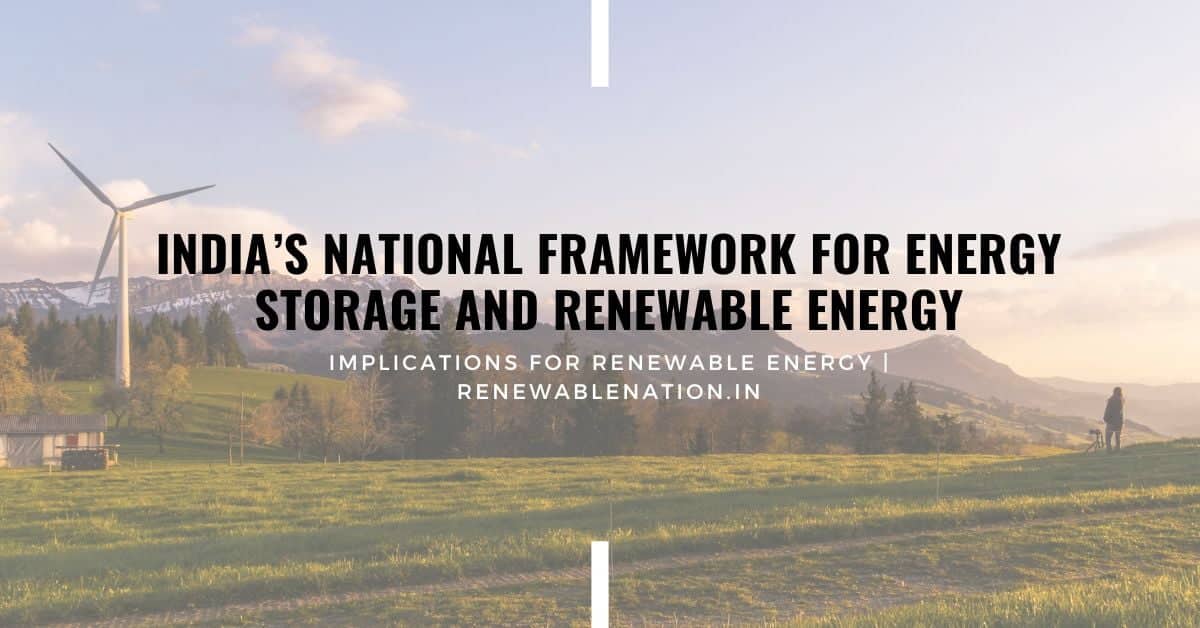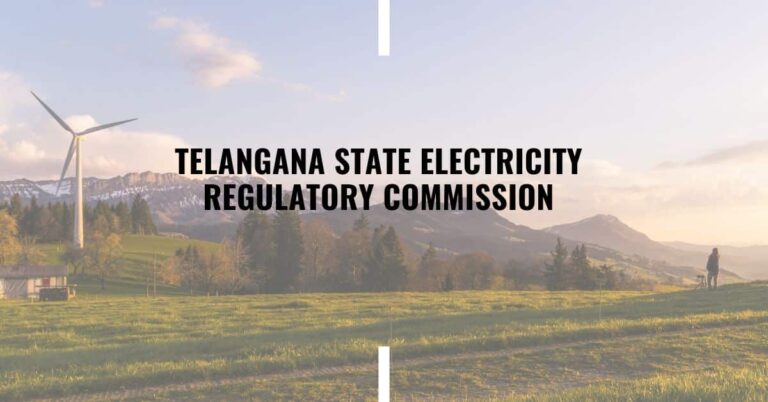
India is aggressively pursuing a transition from fossil fuels to renewable energy with an aim to achieve 50% non-fossil fuel-based capacity by 2030. To meet this goal, the country has launched several initiatives such as the National Solar Mission and National Mission for Enhanced Energy Efficiency. As renewable energy sources like solar and wind are variable, there\’s a growing need for efficient energy storage systems (ESS) to maintain grid stability and allow for 24×7 power supply. The National Framework on Energy Storage Systems outlines objectives, estimates storage requirements, and details applications to facilitate this shift.
Context & Challenges:
- India aims to achieve 50% non-fossil fuel-based energy by 2030.
- Intermittent nature of Renewable Energy (RE) poses challenges in maintaining grid stability.
- Energy Storage Systems (ESS) can mitigate these challenges by storing energy for later use.
Objectives of the ESS Framework
- Ensure 24×7 dispatchable RE power.
- Reduce greenhouse gas emissions.
- Support ESS through policy, financial incentives, and market redesign.
- Improve grid stability and promote energy independence.
- Foster innovation and ensure equitable access to energy storage.
Storage Requirements
- Estimated energy storage capacity required ranges from 16.13 GW in 2026-27 to 73.93 GW in 2031-32, with significant financial implications.
- By 2047, the storage capacity requirement is expected to soar to 320 GW due to net zero emissions targets for 2070.
Applications and Use Cases
- ESS can be integrated at various levels including generation, transmission, and distribution.
- Applications include grid stability, peak load management, and ancillary services.
ESS also opens up opportunities for energy trading and leasing.
By prioritizing energy storage, India aims to create a robust, sustainable, and financially viable power sector that can meet the twin objectives of energy transition and energy security.
The Indian Ministry of Power has developed a comprehensive policy framework for promoting Energy Storage Systems (ESS) in the country. The highlights are:
Legal Status
- ESS is considered part of the power system.
- ESS can work with generation, transmission, and distribution infrastructure.
- ESS owners can lease storage to utilities or use it themselves for energy trading.
Energy Storage Obligation (ESO)
- A long-term trajectory for ESO mandates that a certain percentage of energy be stored.
- The ESO will rise from 1% in FY 2023-24 to 4% by FY 2029-30.
Waiver of Charges
- Waiver of Inter-State Transmission System (ISTS) charges until June 2025 to encourage renewable energy integration.
Replacement of Diesel Generators
- Mandate for consumers using Diesel Generators to transition to cleaner technologies like renewable energy with battery storage within five years.
Guidelines for Battery Energy Storage Systems (BESS)
- Detailed procurement and utilisation guidelines for BESS.
- Emphasises standardisation and risk-sharing among stakeholders.
Pumped Storage Projects (PSPs)
- Guidelines for developing PSPs, including criteria for site awards and environmental clearances
Timely Approvals
- Central Electricity Authority (CEA) reduced timelines for approving Detailed Project Reports for PSPs.
High Price Day Ahead Market (HP-DAM)
- Framework allows ESS to participate in the HP DAM segment of the Energy Exchange.
Infrastructure Recognition
- ESS is recognized as essential infrastructure, enabling easier access to institutional credit.
Budgetary Support
- Support for infrastructure development in remote areas where PSPs are developed
Must-Run Rules
- Renewable power plants are designated as must-run, encouraging the use of ESS to avoid curtailments.
Ancillary Services
- ESS are eligible to provide ancillary services under new regulations, adding another revenue stream for ESS providers.
Technical Standards
- Regulatory norms laid out for ESS connectivity to the grid at voltage levels of 33kV and above.
Round-the-Clock (RTC) Renewable Energy Supply
- Guidelines to facilitate the procurement of continuous renewable power, boosting demand for ESS.
The framework provides a roadmap for ESS but also recognizes the need for future policy adjustments to keep pace with sectoral developments.
This outlines several initiatives and guidelines designed to promote the development and adoption of Energy Storage Systems (ESS) in the power sector. These are divided into multiple sections:
Financial Incentives
- Viability Gap Funding for Battery Energy Storage Systems (BESS): Funding up to 40% of capital costs is proposed for early BESS projects to make them economically viable. These projects must be operational within 18 to 24 months.
- Infrastructure Support for Pumped Storage Projects: Additional budgetary support is offered for building essential infrastructure, especially in remote areas.
- Green Finance: Sovereign Green Bonds and long-term loans from specific financial institutions are proposed to finance green initiatives.
Guidelines for Resource Adequacy:
- New guidelines will ensure that there are enough generation and demand-responsive resources to meet peak demand.
- Resource Adequacy Plans (RAPs) will be developed at both national and distribution levels to integrate ESS into the planning process.
- Penalties for non-compliance with approved resource adequacy targets are suggested.
Connectivity and Grid Access
- Priority will be given for connecting ESS to Inter-State and Intra-State Transmission Systems.
- Planning authorities are urged to include ESS in future transmission system plans.
Technology and Procurement
- The Central Government may issue \”technology agnostic\” guidelines to promote a diverse range of ESS technologies.
- Different models for tariff and bidding are discussed to assist utilities and developers.
Storage Capacity with Future Renewable Generations
- New Renewable Energy projects may be mandated to have a minimum level of energy storage to manage variability and peak demand.
Regulatory Measures
- ESS developers will be permitted to offer a variety of market-based energy and power products.
- Power purchase guidelines may be reframed to encourage ESS adoption.
- Time of Day tariffs are proposed to optimise power costs, and carbon credits may be offered to ESSs that use renewable energy.
Overall, this aims to create a comprehensive framework that covers financial incentives, guidelines, and regulatory measures to facilitate the development and adoption of energy storage systems.
Tax Benefits & Duties
- The Government may offer tax incentives to boost the ESS sector.
- Duties like Electricity Duty (ED) and Cross Subsidy Surcharge (CSS) might not apply during the charging of ESS; these would be levied only on final electricity consumption.
Land & Infrastructure
- States may exempt stamp duty and registration fees for lands acquired for ESS.
- Government land could be offered at concessional rates for these projects.
Indigenous Technology
- A Production Linked Incentive (PLI) Scheme may be introduced for Battery Energy Storage Systems (BESS).
- The scheme would be technology-agnostic and incentivize advanced technologies.
Quality & Standards
- The government may issue an \”Approved List of Models and Manufacturers\” for BESS, akin to what exists for solar modules.
- Specifications, including fire safety, would be defined by appropriate agencies.
- Testbeds may be established to check the commercial readiness of ESS.
Research & Development
- With a growing energy demand and a shift to renewable sources, the document calls for investing in R&D for ESS technologies.
- A Nodal Agency could be established for coordination, and a national portal could facilitate knowledge sharing.
Training
- Institutes may offer training programs to upskill manpower in ESS technologies.
Pilot Projects
- Demonstrations for novel storage technologies may be undertaken by Central/State Public Sector Undertakings (CPSUs/SPSUs/IAs).
- Funding for pilot projects may come from various designated funds.
Recycling & Sustainability
- A circular economy approach is recommended, based on the principles of Reduce, Reuse, and Recycle.
- Manufacturers may design systems with end-of-life management in mind.
- Waste Management Centers for e-waste collection and recycling may be set up.
Repurposing
- Discarded mines and other such locations could be repurposed for ESS.
Monitoring & Evaluation
- A dynamic strategy to monitor and revise the framework for ESS is suggested.
- Concessions and incentives should be temporary, with the goal of making ESS self-sustaining in the long term.
- The overarching goal is to ensure the rapid, sustainable, and standardized growth of the ESS sector, with a focus on quality, indigenous manufacturing, and environmental responsibility.



